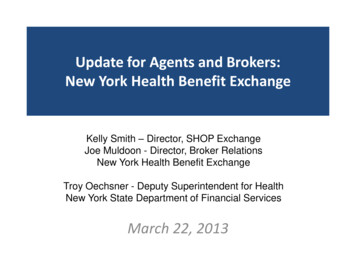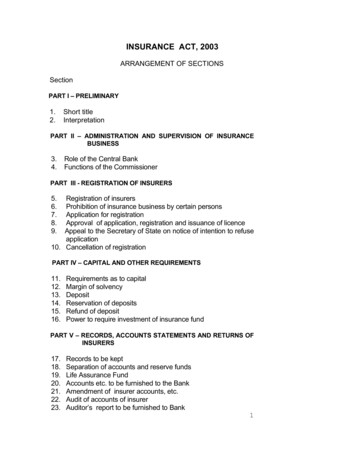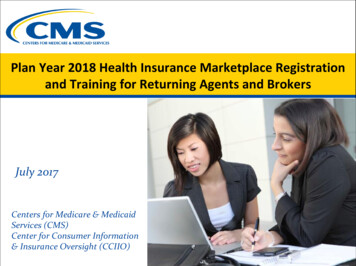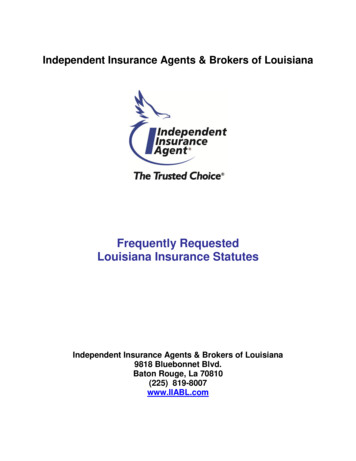
Transcription
Update for Agents and Brokers:New York Health Benefit ExchangeKelly Smith – Director, SHOP ExchangeJoe Muldoon - Director, Broker RelationsNew York Health Benefit ExchangeTroy Oechsner - Deputy Superintendent for HealthNew York State Department of Financial ServicesMarch 22, 2013
Goals Provide an update on the Exchange, sharenew information and facilitate brokerengagement Introduce a series of interactive webinars toprepare for your participation in theExchange Encourage your use of the Exchange websiteas a tool for staying informedwww.HealthBenefitExchange.ny.gov2
Agenda Current Market StateWhat is an ExchangeUrban Institute Data - NEWNew York SHOP Design - Wakely Consulting AnalysisPreparing Brokers to Participate in the SHOP Exchange–––––Policy decisionsAdministrative overviewBroker engagementCertificationOngoing education and communication Exchange Timelinewww.HealthBenefitExchange.ny.gov3
New York’s Uninsured Today nearly 2.7 million New Yorkers under age 65,about 16 percent, do not have health insurancecoverage Primarily workers and their families Uninsured people forego necessary care due to costs Taxpayers and the insured shoulder the burden ofpaying for the care of the uninsuredwww.HealthBenefitExchange.ny.gov4
What is an Exchange? Organized marketplace– Easily compare health plan options– Makes available tax credits and cost-sharing subsidies– Easily enroll in Qualified Health Plans (QHPs) Two programs– “Individual Exchange“– “Employer Exchange“ called the Small Business HealthOptions Program (SHOP)www.HealthBenefitExchange.ny.gov5
Functions of the ExchangeEligibility and Enrollment toll-free telephone hotline web portal for eligibilitydetermination and enrollment ability to calculate the actual costof coverage after individual taxcredits and cost sharing reductions certify individuals as exempt fromindividual responsibilityCertify Qualified Health Plans (QHPs) Make available qualified health anddental plans to eligible individuals andemployers Assign a quality rating and actuarialvalue to each QHP offered though theExchange Require QHPs to offer Essential HealthBenefits Ensure adequacy of plan networkswww.HealthBenefitExchange.ny.gov
New York Health Benefit ExchangeTotal Exchange EnrollmentSHOPExchange44%IndividualExchange56%N 1 million peopleNote: The results in this report assume small employer size is set to 100 employees, non-group and small group markets remain separate, and thatBasic Health Plan is not implemented, consistent with modeling assumptions for “Alternative 1” in the March 2012 report.Source: Urban Institute, Characteristics of Nonelderly New Yorkers Likely to Enroll in the Health Insurance Exchanges Under the Affordable CareAct, February 2013.
New York Health Benefit ExchangeEnrollee Characteristics, by IncomeIndividual Exchange14%SHOP ExchangeUnder 138% FPL8%12%138-200% FPL40%13%12%200-300% FPL41%300-400% FPL23%24%Above 400% FPL13%Source: Urban Institute, Characteristics of Nonelderly New Yorkers Likely to Enroll in the Health Insurance Exchanges Under the AffordableCare Act, February 2013.
New York Health Benefit ExchangeEnrollee Characteristics, by AgeIndividual ExchangeN 560,000SHOP ExchangeN te: The results in this report assume small employer size is set to 100 employees, non-group and small group markets remain separate, and thatBasic Health Plan is not implemented, consistent with modeling assumptions for “Alternative 1” in the March 2012 report.Source: Urban Institute, Characteristics of Nonelderly New Yorkers Likely to Enroll in the Health Insurance Exchanges Under the Affordable CareAct, February 2013.
New York Health Benefit ExchangeEnrollee Characteristics, by Coverage StatusIndividual ExchangeN 560,000SHOP ExchangeN 430,0006%41%CurrentlyInsuredUninsured59%94%Note: The results in this report assume small employer size is set to 100 employees, non-group and small group markets remain separate, and thatBasic Health Plan is not implemented, consistent with modeling assumptions for “Alternative 1” in the March 2012 report.Source: Urban Institute, Characteristics of Nonelderly New Yorkers Likely to Enroll in the Health Insurance Exchanges Under the Affordable CareAct, February 2013.
Wakely Study – Value PropositionsChoice Employers and employees regard expanded choice as a keyadvantage to using the Exchange.Administrative Simplicity The Exchange provides monthly billing to employers alongwith other administrative simplifications.Tax Credits The Exchange will be the exclusive place to access smallbusiness tax credits in 2014.Defined Contribution 76% of respondents believe this feature helps predict costs.www.HealthBenefitExchange.ny.gov11
Key Policy DecisionsRelated to the SHOP Exchange Small Group Market Size 2-50 in 2014 Must raise to 100 by 2016 Market Merger - Individual and Small Group Markets Not a federally required decision NY will leave markets as is for 2014 Benchmark Plan Selection All QHPs have to offer the benchmark plan in each metal tier Additional non-standard plans may be offered; all mustinclude Essential Health Benefitswww.HealthBenefitExchange.ny.gov12
QHP Metal TiersEnrollees have choice of QHP coverage levels: Platinum – 90% actuarial value Gold – 80% actuarial value Silver – 70% actuarial value Bronze – 60% actuarial value Catastrophic plan available only for people under 30, orthose with a financial or hardship exemption.– Sold only in the individual Exchangewww.HealthBenefitExchange.ny.gov13
Administrative Simplicity Exchange provides employers a single monthly bill– Monthly bill will include relevant breakdown ofemployer/employee contribution due to each QHP(employers remain responsible for collecting premiumsfrom employees). Exchange collects employer contributions andremits payment to insurers Employers using the Exchange may be eligible forSmall Business Health Care Tax Creditwww.HealthBenefitExchange.ny.gov14
Small Business Health Care Tax Credit Internal Revenue Code - 45R Exchange provides real-time estimate of credit attime of application for those who qualify Available to small business with fewer than 25employees and average salary of 50k or less Maximum credit– 50% of employer contribution– 35% for tax-exempt (10 or fewer employees and averageannual salary of 25k or less) Advised to work with tax advisor for tax informationwww.HealthBenefitExchange.ny.gov15
Employer Coverage and Contribution OptionsEmployer CoverageOptionsEmployer Contribution Options1) Select among QHPs offeredby a specific carrier1) Uncapped percentage2) Select specific QHPs offeredby multiple carriers2) Capped percentage3) Select a metal tier ofcoverage(e.g., employer pays 55% of premium)(e.g., employer pays 55% of premium, up to 300)3) Defined dollar amount(e.g., employer pays 300/month)4) Allow employees to selectany Exchange QHPwww.HealthBenefitExchange.ny.gov16
Customer Assistance and Enrollment SupportOnline— Through the Exchange portal (Broker and Employer portals)— Process new applications and renewalsIn-Person— Brokers List of certified brokers will be available on the website— In-Person Assistors/NavigatorsPhone and Mail— Call center capability in English, Spanish and TDD— Language Line available for additional languages— Written materials in several languages and Braillewww.HealthBenefitExchange.ny.gov17
Broker Engagement Brokers will be a primary distribution channel for small group enrollmentin the SHOP 88% of NYS small group coverage currently sold through brokers Brokers also can choose to become certified to sell products in theindividual Exchange Brokers will have the support of a dedicated online portal to facilitateapplications and renewals Broker can also serve as employer proxy in employer portal Exchange will support brokers with a full customer service center Commissions will be paid directly from carrierswww.HealthBenefitExchange.ny.gov18
Getting Started:SHOP Education and Certification Curriculum delivered in cooperation with NYSDepartment of Financial Services Continuing Education credit eligible Satisfactory completion of curriculum and written examrequired Execute broker agreement with the Exchange Curriculum available mid-summer 2013www.HealthBenefitExchange.ny.gov19
Getting Started:Individual Exchange Education and Certification Offers an opportunity to gain additional expertiserelated to the individual market Curriculum focuses on public program eligibility Emphasis on individual tax credit qualification Curriculum available mid-summer 2013www.HealthBenefitExchange.ny.gov20
Next Steps for Broker Engagement Exchange will offer a series of web-basedinformational meetings for brokers Topics will include:– Employer/broker portal overview– Education and certification requirements– Results of Health Plan Invitation Participating carriers, QHPs, benefit summaries, rates Regular updates via website and email alertswww.HealthBenefitExchange.ny.gov21
Exchange Timeline Executive Order Issued - April 2012NY completes HHS Design Review - October 2012NY submits Blueprint to HHS – November 2012NY receives conditional certification from HHS to operate a state-basedExchange -December 2012HHS conducts design review – April 2013Rollout of broker training and certification – Summer 2013QHPs selected for participation in 2014 - July 2013IPA/Navigator Program begins – August 2013Customer Service Center opens for business – September 2013Advertising campaign begins – September 2013Applications accepted – October 2013Coverage starts – January 2014www.HealthBenefitExchange.ny.gov22
Broker ContactsJoe Muldoonjpm14@health.state.ny.usKelly Smithkks03@health.state.ny.usGet regular updates at:www.HealthBenefitExchange.ny.gov23
Update for Agents and Brokers: New York Health Benefit Exchange March 22, 2013 Kelly Smith - Director, SHOP Exchange Joe Muldoon - Director, Broker Relations . Introduce a series of interactive webinars to prepare for your participation in the Exchange Encourage your use of the Exchange website as a tool for staying informed 2










